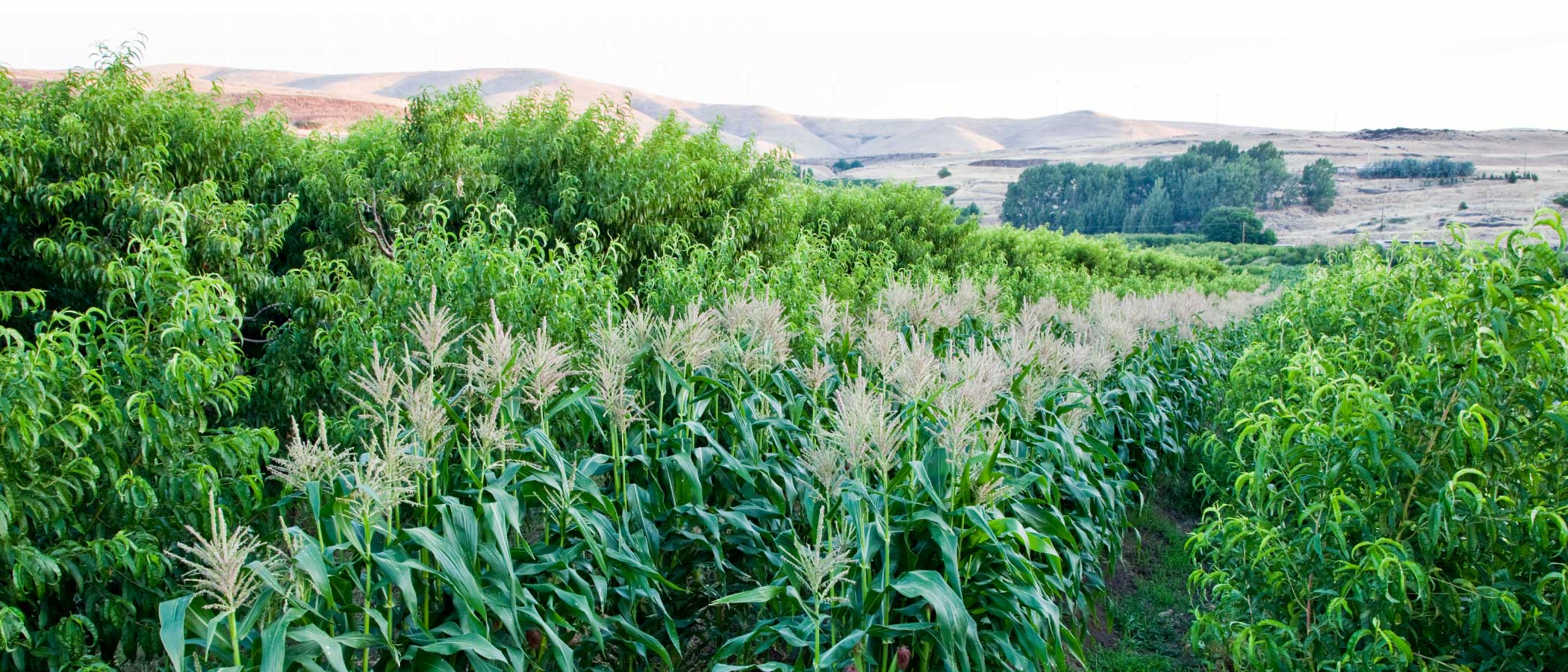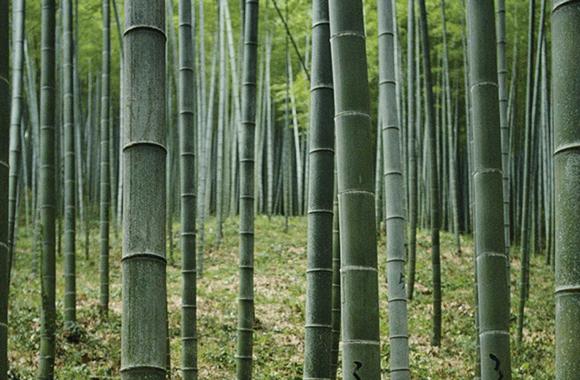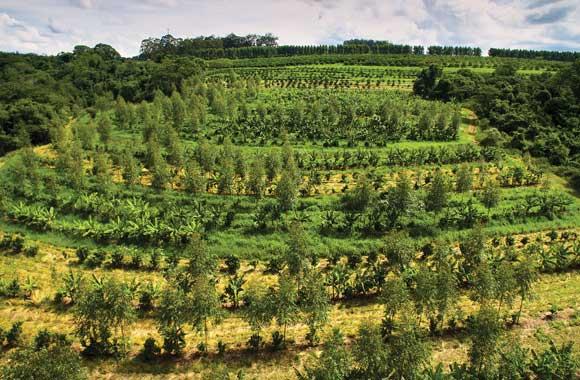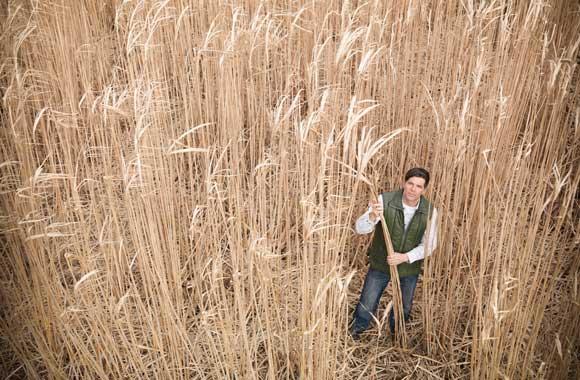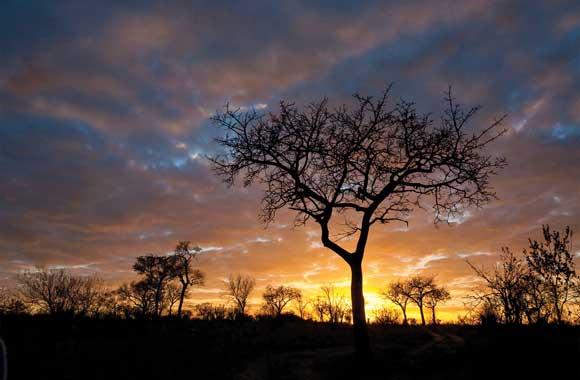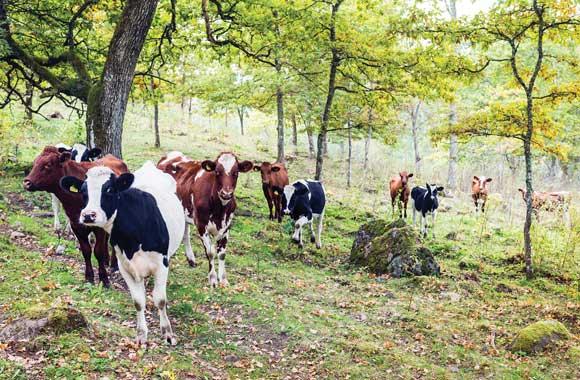Tree Intercropping
Growing trees and annual crops together increase biomass, soil organic matter, and carbon sequestration.
Reduced/Sequestered
2020–2050
To Implement
Operational Savings
Impact
Accounting for different sequestration rates across regions and intercropping systems, we estimate total sequestration of 15.03–24.40 gigatons of carbon dioxide equivalent greenhouse gases over 30 years. To achieve that impact, adoption of tree intercropping would need to grow to 416.93–490.43 million hectares. On an initial investment of US$146.89–227.02 billion and lifetime operational costs of US$0.70–1.08 trillion, the potential net profit could be as high as US$262.40–427.81 billion.
Introduction
Tree intercropping—intermingling trees and crops—increases the carbon content of the soil and productivity of the land. Other benefits include:
- reducing erosion and creating habitat
- protecting fast-growing annuals from wind and rain damage
- drawing up minerals and nutrients for shallow-rooted plants
- protecting light-sensitive crops from excess sunlight.
Tree intercropping has many variations. Some systems use trees to support annual crop production (e.g., intercropping with nitrogen-fixing trees, as in evergreen agriculture) or to protect against erosion, flooding, or wind damage (e.g., hedgerows, riparian buffers, and windbreaks). In other systems, the trees are crops themselves (e.g., strip intercropping of annual crops with timber or fruit trees).
Project Drawdown’s Tree Intercropping solution involves a suite of agroforestry systems that deliberately grow trees together with annual crops in a given area at the same time. This solution replaces conventional annual crop production on degraded cropland.
Tree intercropping is an important strategy for producing annual crops while sequestering carbon in soils and above-ground biomass.
Methodology
Total Land Area
To evaluate the extent to which a Food, Agriculture, and Land Use sector solution can reduce greenhouse gas emissions and sequester carbon, we need to identify the total land area available for that solution. To avoid double counting, we use an integration model that allocates land area among all of the sector’s solutions. This involves two steps. First, we classify the global land area into agroecological zones (AEZs) based on the land cover, soil quality, and slope and assign AEZs to different thermal moisture regimes. We then classify the AEZs into “degraded” and “nondegraded.” Second, we allocate the solutions to AEZs, with the solution most suited to a given AEZ or sets of AEZs assigned first, followed by the second-most-suited solution, and so on. Because it’s hard to predict future changes, we assume the total land area remains constant. Total land areas represent both the implementation and functional unit.
Total land available for the Tree Intercropping solution is 494 million hectares of degraded and nondegraded cropland. Current adoption is allocated on the nondegraded cropland.
To date, accurate and comprehensive data sets on the current adoption levels of different forms of tree intercropping do not exist. Lal et al. (2018) estimated the total global extent of tree intercropping systems at approximately 600 million hectares. A more comprehensive study (Zomer et al., 2014) used global remote sensing data to estimate total global cropland with various levels of tree cover. These data do not necessarily differentiate between tree intercropping systems and small areas with trees adjacent to cropland and should therefore be taken as a rough estimate. Moreover, to avoid double counting, our estimates only consider areas dedicated to tree intercropping, excluding annual cropping areas with sparse trees. These areas are part of our Conservation Agriculture, Regenerative Annual Cropping, Improved Rice Production, and System of Rice Intensification solutions. Our models estimate a global area of 267.87 million hectares under tree intercropping with 10–20 percent canopy cover, based on Global Agro-Ecological Zone cropland data and tree cover data derived from Zomer et al. (2014).
Adoption Scenarios
We based future adoption on 1) historical changes in the percent of agricultural land under 10–20 percent tree cover between 2000 and 2010, as estimated by Zomer et al. (2014); 2) UK projections of future land use change by 2050, as reported by Thomson et al. (2018); and 3) current estimates of tree intercropping adoption in the EU based on den Herder (2017). We developed seven custom adoption scenarios.
We calculated impacts of increased adoption of the Tree Intercropping solution from 2020 to 2050 by comparing two scenarios with a reference scenario in which the market share was fixed at current levels.
- Scenario 1: The solution is adopted on 416.93 million hectares by 2050 (84 percent of total available land area).
- Scenario 2: The solution is adopted on 490.43 million hectares by 2050 (99 percent of total available land area).
Emissions, Sequestration, and Yield Model
We set the sequestration rate for tree intercropping at 1.7 metric tons of carbon per hectare per year, based on 15 data points from nine sources.
Note: this rate assumes tree intercropping with tillage-based annual cropping. Combining tree intercropping with climate-friendly practices like conservation agriculture may well result in sequestration rates higher than either practice alone.
Financial Model
All monetary values are presented in 2014 US$.
We estimated net first costs to implement at US$988.12 per hectare, based on meta-analysis of 11 data points from three sources. We assume there is no conventional first cost because agriculture is already in place on the land. We estimated net profit at US$639.02 per hectare per year for the solution (based on meta-analysis of 14 data points from 10 sources), compared with US$492.81 per year for the conventional practice (based on 67 data points from 35 sources). We estimated the operational cost at US$1,043.02 per hectare per year for the solution (based on 16 data points from four sources), compared with US$895.14 per year for the conventional practice (based on the 57 data points from 25 sources).
Integration
Project Drawdown’s Agro-Ecological Zone model allocates current and projected adoption of solutions to the planet’s forest, grassland, rain-fed cropland, and irrigated cropland areas. Tree intercropping was the top priority for degraded cropland.
Results
The emissions savings under Scenario 1 are 15.03 gigatons of carbon dioxide equivalent by 2050. The net first cost to implement is US$146.89 billion, and the lifetime operational cost is US$0.70 trillion. The lifetime net profit is US$262.40 billion.
The emissions impact of Scenario 2 is 24.40 gigatons of carbon dioxide-equivalent by 2050. The net first cost to implement is US$227.02 billion, and the lifetime operational cost is US$1.08 trillion. The lifetime net profit is US$427.81 billion.
Discussion
Benchmarks
Benchmarks for the climate change mitigation impact of tree intercropping are rare because it is typically considered part of agroforestry, if at all. Lal et al. (2018) estimated 0.40–1.55 megagrams of carbon dioxide equivalent per hectare per year for all global tree intercropping systems, and Griscom et al. (2017) estimated the carbon sequestration potential of all tree intercropping systems at 0.37 megagrams of carbon dioxide equivalent per hectare per year. Benchmarks specific to tree intercropping subtypes are scarce, although Udawatta and Jose (2011) estimated the total sequestration potential of alley cropping at 3.4 megagrams of carbon dioxide equivalent per hectare per year. We calculated an annual impact of tree intercropping in 2030 of 0.37–0.65 gigatons of carbon dioxide equivalent. Thus, this study is generally on target.
Limitations
Additional financial data would increase the utility of the financials of this solution. It would also be valuable to calculate yield impacts. The greenhouse gas impacts of combining tree intercropping with climate-friendly practices like conservation agriculture is an important area for future research.
Conclusions
There is much potential to scale up tree intercropping, for example in the mechanized regions of North and South America. On cropland with moderate to steep slopes, with poor or degraded soils, or other challenges, tree intercropping is an important tool for slope stabilization and restoration and improving degraded and infertile soils. Tree intercropping combines the sequestration power of trees with the ability to continue producing the annual crops humanity depends upon. This solution surely has a major role to play in agricultural mitigation efforts.
References
den Herder, M., Moreno, G., Mosquera-Losada, M. R., Palma, J. H. N., Sidiropoulou, A., Santiago-Freijanes, J., ... & Burgess, P. J. (2017). Current extent and trends of agroforestry in the EU27. Deliverable Report 1.2 for EU FP7 Research Project: AGFORWARD 613520. (15 August 2016). 76 pp.
Lal, R., Smith, P., Jungkunst, H.F., Mitsch, W.J., Lehmann, J., Nair, P.K.R., McBratney, A.B., de Moraes Sá, J.C., Schneider, J., Zinn, Y.L., et al. (2018). The carbon sequestration potential of terrestrial ecosystems. J. Soil Water Conserv. 73, 145A–152A.
Thomson, A., Misselbrook, T., Moxley, J., Evans, C., Malcolm, H., Whitaker, J., and Reinsch, S. (2018). Quantifying the impact of future land use scenarios to 2050 and beyond - Final Report. Final Rep. 78.
Udawatta, R.P., and Jose, S. (2011). Carbon Sequestration Potential of Agroforestry Practices in Temperate North America. In Carbon Sequestration Potential of Agroforestry Systems, B.M. Kumar, and P.K.R. Nair, eds. (Dordrecht: Springer Netherlands), pp. 17–42.
Zomer, R., Trabucco A, Coe, R., Place, F., van Noordwijk, M., and Xu, J.. (2014). Trees on farms: an update and reanalysis of agroforestry’s global extent and socio-ecological characteristics (World Agroforestry Centre (ICRAF)).
What You Can Do
If you farm, explore whether tree intercropping could be a win-win for you and the climate.
Share this page with a local producer of fruit, nuts, or other tree crops. Explain how reducing climate risk today will help their business flourish for generations to come.
- Expand your knowledge by exploring another Drawdown solution.
Co-benefits
Tree intercropping improves soil health and boosts soils' ability to store water, which is beneficial during prolonged dry spells.
It also promotes biodiversity by providing diverse habitats and food sources for a variety of organisms. The presence of trees in agricultural landscapes attracts beneficial insects, birds, and other wildlife, fostering ecological balance and supporting a healthy ecosystem.

